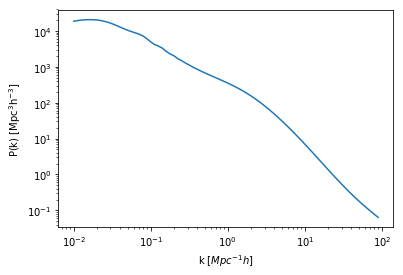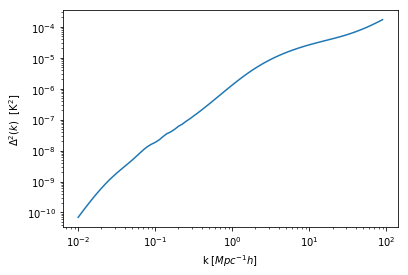Customised extensions with halomod¶
In this tutorial, we use the existing infrastructure of halomod and plug in a new type of tracer, namely HI using the model from arxiv:2010.07985. This model requires three additions: a new density profile for HI; a new concentration-mass relation for HI; and finally a new HI HOD.
halomod is extremely flexible. You can add custom models for any “component” (eg. mass functions, density profiles, bias functions, mass definitions,…). However, most likely you’ll need to add something to build a new type of tracer, which is the case here.
Let’s import a few basic things first:
[1]:
%matplotlib inline
import matplotlib.pyplot as plt
import numpy as np
from halomod import TracerHaloModel
import halomod
import hmf
import scipy
[2]:
print("halomod version: ", halomod.__version__)
print("hmf version:", hmf.__version__)
halomod version: 1.6.1.dev3+ge514be1.d20200819
hmf version: 3.2.2.dev4+g370a013
Creating a new density profile¶
The HI density profile used here is:
Notice that all the infrastructure has been set up by the Profile or ProfileInf class, depending on if you truncate the halos or not. And all you need to modify is the _f function, and optionally its integration _h and its Fourier transform _p (see documentation for `profiles.py <https://halomod.readthedocs.io/en/docs/_autosummary/halomod.profiles.html#module-halomod.profiles>`__). Note that these latter two are useful to speed up calculations, but are in principle
optional and will be calculated numerically.
The _f function is:
The integration in this case is:
where \(\Gamma\) is the Gamma function
The Fourier Transformed profile is:
[3]:
from halomod.profiles import ProfileInf,Profile
from scipy.special import gamma
[4]:
class PowerLawWithExpCut(ProfileInf):
"""
A simple power law with exponential cut-off, assuming f(x)=1/x**b * exp[-ax].
"""
_defaults = {"a": 0.049, "b": 2.248}
def _f(self, x):
return 1. / (x**self.params['b']) * np.exp(-self.params['a']*x)
def _h(self,c=None):
return gamma(3-self.params['b']) * self.params['a']**(self.params['b']-3)
def _p(self, K, c=None):
b = self.params['b']
a = self.params['a']
if b==2:
return np.arctan(K/a)/K
else:
return -1 / K * ((a**2+K**2)**(b/2-1)*gamma(2-b)*np.sin((b-2)*np.arctan(K/a)))
At bare minimum, you must specify _f which is just the density profile itself, and all the integration and Fourier transformation will be done numerically. However, that is very inefficient so you should always find analytical expression and specify if you can.
Now let’s plug it into a halo model:
[5]:
hm = TracerHaloModel(
tracer_profile_model=PowerLawWithExpCut,
transfer_model='EH'
)
Note that as of v2 of halomod, defining a new model for any particular component will automatically add it to a registry of ‘plugins’, and you may then construct the overall model using a string reference to the model (i.e. we could have passed tracer_profile_model="PowerLawWithExpCut").
And see the profile for a halo of mass \(10^{10} M_\odot h^{-1}\) in Fourier space:
[6]:
plt.plot(hm.k,hm.tracer_profile_ukm[:,1000]);
plt.xscale('log')
plt.yscale('log')
plt.xlim((1e-2,1e5));
#plt.ylim((1e-1,1))

And we’ve set up our profile model.
This profile model has 2 additional model parameters. You can always update these parameters using:
[7]:
hm.tracer_profile_params = {"a": 0.049, "b": 2.248}
Creating a new concentration-mass relation¶
The concentration-mass relation we use here follows the one from Maccio et al.(2007):
Again, because halomod already has a generic CMRelation class in place, all you really need is to specify a cm function for the equation above:
[8]:
from halomod.concentration import CMRelation
from hmf.halos.mass_definitions import SOMean
[9]:
class Maccio07(CMRelation):
"""
HI concentration-mass relation based on Maccio et al.(2007).
Default value taken from 1611.06235.
"""
_defaults = {'c_0': 28.65, "gamma": 1.45}
native_mdefs = (SOMean(),)
def cm(self,m,z):
return self.params['c_0']*(m*10**(-11))**(-0.109)*4/(1+z)**self.params['gamma']
Note that for the concentration-mass relation that you put in, you need to specify the mass definition that this relation is defined in. In this case, it is defined in Spherical-Overdensity method, which is the default.
And set this to be the model for the tracer concentration-mass relation:
[10]:
hm.tracer_concentration_model = Maccio07
And check the concentration-mass relation at z=0:
[11]:
plt.plot(hm.m,hm.tracer_concentration.cm(hm.m,0))
plt.xscale('log')
plt.xlim(1e5,1e15)
plt.ylim((1e1,1e3))
plt.yscale('log');

Notice that this model has two additional parameters, which can be updated using:
[12]:
hm.tracer_concentration_params={'c_0': 28.65, "gamma": 1.45}
See the documentation for `concentration.py <https://halomod.readthedocs.io/en/docs/_autosummary/halomod.concentration.html>`__ for more.
Creating a new HOD¶
The HI HOD we use here is:
For the HOD, it’s a bit more complicated. First, one needs to decide what type of tracer it is. The most generic class to use is HOD, however, you may prefer HODBulk where the tracer is considered to be continuously distributed ; or HODPoisson, which assumes Poisson distributed discrete satellite components, which is commonly used for galaxies.
Second, if your model has a minimum halo mass to host any tracer as a sharp cut-off (or not), you should specify in your model definition
sharp_cut = True # or False
If your model has a seperation of central and satellite components, you need to specify if the satellite occupation is inherently dependent on the existence of central galaxies:
central_condition_inherent = False # or True
If False, the actual satellite component will be your satellite occupation times occupation for central galaxies.
See the documentation for `hod.py <https://halomod.readthedocs.io/en/docs/_autosummary/halomod.hod.html>`__, or the reference paper for more.
Finally, you need to specify how to convert units between your HOD and the resulting power spectrum. For example, for HI the HOD is written in mass units, whereas the power spectrum is in temperature units. This is done by specifying a unit_conversion method.
Additionally, sometimes your HOD contains methods that need to be calculated, such as virial velocity of the halos, which you can just put into the class.
[13]:
from halomod.hod import HODPoisson
import scipy.constants as const
import astropy.constants as astroconst
And in our case for utility, we also specify the number of galaxies in this model, which is defined by _tracer_per_central and _tracer_per_satellite:
[14]:
class Spinelli19(HODPoisson):
"""
Six-parameter model of Spinelli et al. (2019)
Default is taken to be z=1(need to set it up manually via hm.update)
"""
_defaults = {"a1": 0.0016, # gives HI mass amplitude of the power law
"a2": 0.00011, # gives HI mass amplitude of the power law
"alpha": 0.56, # slope of exponential break
"beta": 0.43, # slope of mass
"M_min": 9, # Truncation Mass
"M_break": 11.86, # Characteristic Mass
"M_1": -2.99, # mass of exponential cutoff
"sigma_A": 0, # The (constant) standard deviation of the tracer
"M_max": 18, # Truncation mass
"M_0": 8.31, # Amplitude of satellite HOD
"M_break_sat": 11.4, # characteristic mass for satellite HOD
"alpha_sat": 0.84, # slope of exponential cut-off for satellite
"beta_sat": 1.10, # slope of mass for satellite
"M_1_counts": 12.851,
"alpha_counts": 1.049,
"M_min_counts": 11, # Truncation Mass
"M_max_counts": 15, # Truncation Mass
"a": 0.049,
"b": 2.248,
"eta": 1.0
}
sharp_cut = False
central_condition_inherent = False
def _central_occupation(self, m):
alpha = self.params['alpha']
beta = self.params['beta']
m_1 = 10 ** self.params['M_1']
a1 = self.params['a1']
a2 = self.params['a2']
m_break = 10 ** self.params['M_break']
out = m * (a1 * (m / 1e10) ** beta
* np.exp(-(m / m_break) ** alpha)
+ a2) * np.exp(-(m_1 / m) ** 0.5)
return out
def _satellite_occupation(self, m):
alpha = self.params['alpha_sat']
beta = self.params['beta_sat']
amp = 10 ** self.params['M_0']
m1 = 10 ** self.params['M_break_sat']
array = np.zeros_like(m)
array[m >= 10 ** 11] = 1
return amp * (m/m1) ** beta * np.exp(-(m1/m)**alpha) * array
#return 10**8
def unit_conversion(self, cosmo, z):
"A factor (potentially with astropy units) to convert the total occupation to a desired unit."
A12=2.869e-15
nu21cm=1.42e9
Const=(3.0*A12*const.h*const.c**3.0 )/(32.0*np.pi*(const.m_p+const.m_e)
*const.Boltzmann * nu21cm**2);
Mpcoverh_3=((astroconst.kpc.value*1e3)/(cosmo.H0.value/100.0))**3
hubble = cosmo.H0.value * cosmo.efunc(z)*1.0e3/(astroconst.kpc.value*1e3)
temp_conv=Const*((1.0+z)**2/hubble)
# convert to Mpc^3, solar mass
temp_conv=temp_conv/Mpcoverh_3 * astroconst.M_sun.value
return temp_conv
def _tracer_per_central(self, M):
"""Number of tracers per central tracer source"""
n_c = np.zeros_like(M)
n_c[
np.logical_and(
M >= 10 ** self.params["M_min_counts"],
M <= 10 ** self.params["M_max_counts"],
)
] = 1
return n_c
def _tracer_per_satellite(self, M):
"""Number of tracers per satellite tracer source"""
n_s = np.zeros_like(M)
index = np.logical_and(
M >= 10 ** self.params["M_min_counts"],
M <= 10 ** self.params["M_max_counts"],
)
n_s[index] = (M[index] / 10 ** self.params["M_1_counts"]) ** self.params[
"alpha_counts"
]
return n_s
And now update the halo model with this newly defined HOD:
[15]:
hm.hod_model = Spinelli19
You can check out the mean density of HI in units of \(M_\odot h^2 {\rm Mpc}^{-3}\):
[16]:
hm.mean_tracer_den
[16]:
120813816.44368672
And in temperature units:
[17]:
hm.mean_tracer_den_unit
[17]:
3.7984126901704376e-05
You can easily update the parameters using:
[18]:
hm.hod_params={"beta": 1.0}
And to confirm it is indeed updated let’s check the density again:
[19]:
print(hm.mean_tracer_den)
print(hm.mean_tracer_den_unit)
865801310.8293921
0.0002722098169751524
And the power spectrum in length units:
[20]:
plt.plot(hm.k_hm, hm.power_auto_tracer)
plt.xscale('log')
plt.yscale('log')
plt.xlabel("k [$Mpc^{-1} h$]")
plt.ylabel(r"$\rm P(k) \ [{\rm Mpc^3}h^{-3}]$");
/home/steven/Documents/Projects/halos/HALOMOD/halomod/src/halomod/halo_model.py:1291: RuntimeWarning: overflow encountered in double_scalars
c[i] = tools.spline_integral(self.m, intg, xmin=10 ** mmin)

And in temperature units:
[21]:
plt.plot(hm.k_hm, hm.power_auto_tracer*hm.mean_tracer_den_unit**2 * hm.k_hm**3 / (2*np.pi**2))
plt.xscale('log')
plt.yscale('log')
plt.xlabel("k [$Mpc^{-1} h$]")
plt.ylabel(r"$\Delta^2(k) \ \ [{\rm K}^2]$");

From v2.0.0, all of these HI component models, from arxiv:2010.07985 are available in halomod. To use this model in full, simply call:
[22]:
hm=TracerHaloModel(
hod_model="Spinelli19",
tracer_concentration_model="Maccio07",
tracer_profile_model="PowerLawWithExpCut",
z=1, #for default value of hod parameters,
transfer_model='EH'
)